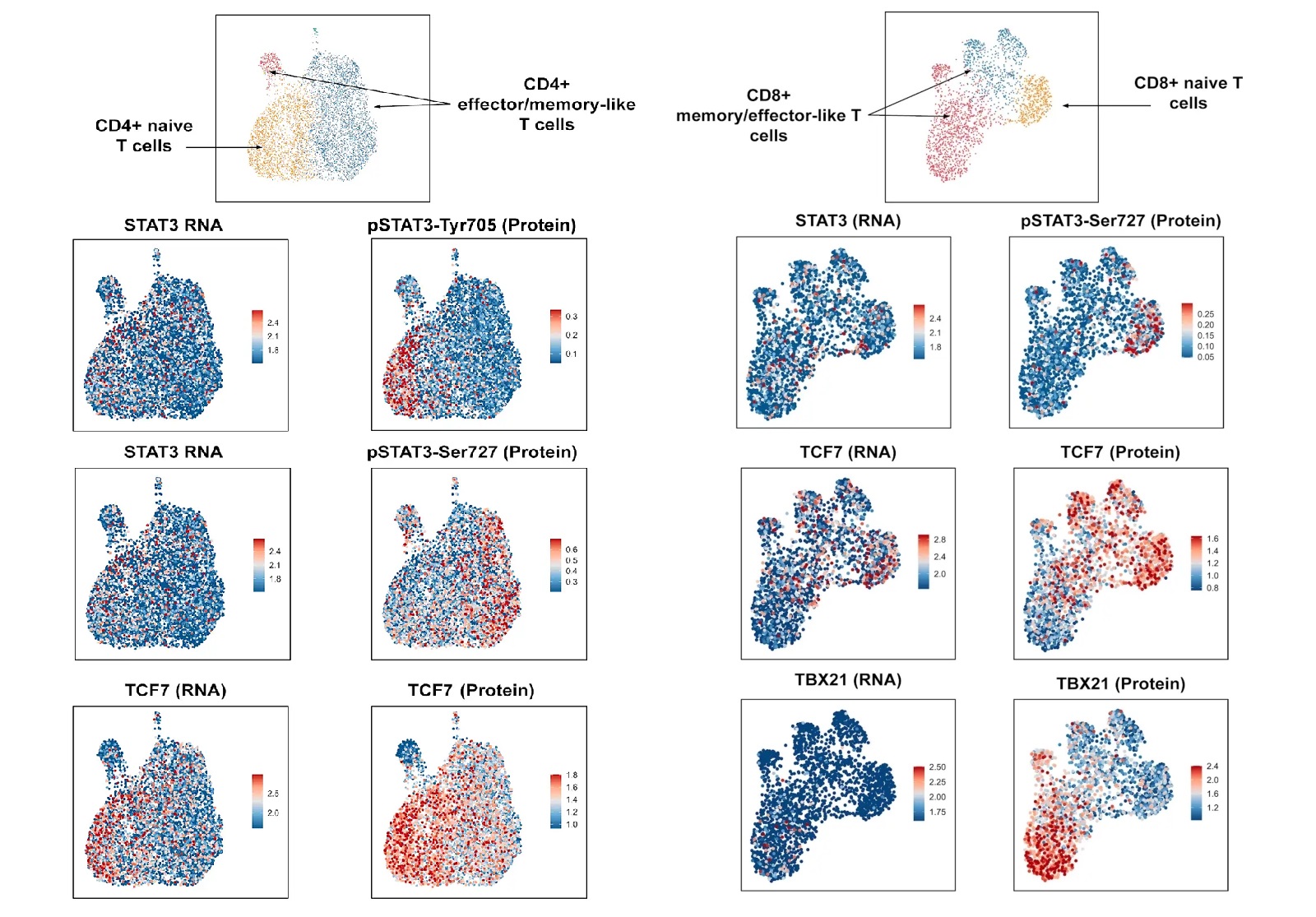シングルセルレベルで同時にRNAの測定と細胞タイプの決定、さらに細胞内シグナル伝達の検出ができるとしたらどうでしょうか。そのようなアッセイが実現すれば、それはシグナル伝達研究用の画期的な解析手法となり、疾患の進行と治療への応答に関する理解を一変します。また、得られる包括的なデータセットにより、細胞タイプの違いがRNAレベルやタンパク質発現にどのような違いをもたらすか、さらにその逆も直接測定できるようになり、疾患状態の組織と健康な組織の違いに関するより深い知見が得られるかもしれません。
何年もの間、科学者は、そのようなアッセイを実現しようと試みてきましたが、RNAを損なうことなく細胞内のデータや翻訳後修飾 (PTM) を測定することは困難でした。新たな手法もいくつか登場していますが、その多くは様々な業界や研究室、アプリケーションに一貫して通用する再現性が欠けています。
しかし、最先端の10x Genomics Chromiumgene expression technologyとフィーチャーバーコード、そして厳密に検証されたCST抗体を活用した新手法であるInTraSeq™シングルセル解析アッセイは、これらのデータの同時取得を可能にします。
 図1: 左:大半のシングルセル解析技術は、RNAを検出しながら、バーコード標識抗体を用いて細胞表面のタンパク質を測定して表現型を解析します。中央:そのうちの多くは、細胞内タンパク質を検出することに重点を置いて開発されているため、RNAの分解または喪失が生じます。右:InTraSeqアッセイは、RNAレベルを保持しつつ、RNAと細胞内および細胞表面のタンパク質を同時検出できます。
図1: 左:大半のシングルセル解析技術は、RNAを検出しながら、バーコード標識抗体を用いて細胞表面のタンパク質を測定して表現型を解析します。中央:そのうちの多くは、細胞内タンパク質を検出することに重点を置いて開発されているため、RNAの分解または喪失が生じます。右:InTraSeqアッセイは、RNAレベルを保持しつつ、RNAと細胞内および細胞表面のタンパク質を同時検出できます。
「InTraSeqは、細胞内のシグナル伝達をシングルセルレベルで調査できる技術であり、さらにscRNA-seqと組み合わせることができます。」と、ハーバード大学医学部大学院神経学部のSamuel L. Wasserstrom教授であり、ブリガムアンドウィメンズ病院の上級科学者およびCSTのコンサルタントを務めるVijay Kuchroo獣医学博士は述べます。「これは、本当に画期的な技術です。」
しかし、なぜ1つのサンプルからシングルセルレベルでRNAと細胞内シグナル伝達のデータを同時検出することが困難だったのでしょうか?このブレークスルーを理解するには、研究者がトランスクリプトームとプロテオームの情報を組み合わせる際に直面する課題を理解する必要があります。
再現性のあるマルチオミクスおよびマルチモデルのscRNA-seqアッセイの開発
研究者はこれまで、細胞内シグナル伝達研究は細胞集団レベルで行っていました。例えば、翻訳後修飾 (PTM) を解析する際は、細胞を破壊し、ウェスタンブロッティングまたは免疫沈降などで解析します。しかし、このアプローチでは、細胞集団全体にわたるシグナル伝達活性の総合的なデータしか得られません。
「シングルセルRNAシーケンシングを用いた解析により、不均一なサンプルに含まれる個々の細胞は異なる様々な機能を持つことが分かっています。」とInTraSeqの開発に深く携わったCSTのシニアサイエンティストであるMajd Arissは述べます。「複雑な腫瘍やそれらの微小環境などといった疾患状態の組織において、これらの個々の細胞を区別することは非常に重要です。このような組織では、それぞれの異なる細胞タイプが、その空間的配置に応じて様々な生物学的プロセスを示します。」
長年、1番の課題であったのは、scRNA-seq実験でトランスクリプトミクスデータを取得すると同時に、細胞内のPTMまたは細胞質のタンパク質、あるいはその両方を同定するアッセイを用いて細胞タイプの機能的な指標を得ることでした。これらのうちの1つ、または2つを取得できる手法はいくつかありますが、1つのサンプル内でそれらを同時検出するわけではありません。つまり、細胞生物学の部分的な情報しか得られません。
「RNAは分解されやすいため、多くの手法では細胞内タンパク質を検出する際にRNAを喪失してしまいます。」とArissは説明します。「これが、同じ細胞からトランスクリプトームとプロテオームの情報を同時に取得することが困難な理由です。」
さらに、シグナル伝達イベントや転写活性の変化のタイムスケールは目まぐるしく変化しており、迅速なシグナル伝達イベントが長期的な転写活性の変化にどのように影響するのかを理解するために、この時間的なギャップを埋めることが大きな課題となっています (図2)。
 図2:シグナル伝達イベントは数分から数時間で起こるのに対し、RNAの転写やタンパク質の翻訳は約1時間から数日かかります。
図2:シグナル伝達イベントは数分から数時間で起こるのに対し、RNAの転写やタンパク質の翻訳は約1時間から数日かかります。
「シグナル伝達イベントは、数分から1時間程度で起こりますが、転写には数時間から数日かかります。」と、Kuchroo博士は述べます。「ですから、10分間で何が起こったか、それが数日かけてどのような影響を与えるのか、後でどのように機能するのかは、解明すべき興味深い謎です。InTraSeqを用いれば、これらの謎を解明できるかもしれません。」
ArissとCSTのチームは、Kuchroo博士や他の一線で活躍する研究者と協力して、シグナル伝達や転写、翻訳といった異なるタイムスケールを正確に調整できる計算手法を開発しました。
「私たちは、CSTのMajd氏と密接に連携してアイデアを出し合い、これらのツールをどのように用いて問題解決に取り組むべきかを考えました。」と、Kuchroo博士は述べます。「また、InTraSeq抗体やその他の試薬に関してだけでなく、タイムスケールの異なるデータをどのように計算上で組み合わせるかについても考えました。」
そして辿り着いたのがInTraSeq技術であり、オリゴ標識抗体を活用した簡単なプロトコールの複合的scRNA-seqアッセイを用いて、1つのサンプルからRNAと細胞内PTMを含むタンパク質のプロファイリングデータを取得できるようになりました。このブレークスルーにより、研究者は、シグナル伝達イベントと個々の細胞における転写活動を関連付けて、細胞の不均一性と機能をより包括的に理解することができます。
 図3:単離したCD4陽性細胞とCD8陽性細胞を、InTraSeqの細胞内およびシグナル伝達の抗体を用いて解析し、RNA-seqだけでは困難な細胞内の状態の特定を行いました。InTraSeqアッセイでは、細胞内の亜集団についての比類ない知見が得られるため、疾患のメカニズムをより深く理解できます。
図3:単離したCD4陽性細胞とCD8陽性細胞を、InTraSeqの細胞内およびシグナル伝達の抗体を用いて解析し、RNA-seqだけでは困難な細胞内の状態の特定を行いました。InTraSeqアッセイでは、細胞内の亜集団についての比類ない知見が得られるため、疾患のメカニズムをより深く理解できます。
「現在では、シグナル伝達に含まれる目的の分子を調べるだけでなく、細胞内のシグナル伝達ネットワーク全体を確認し、そのシグナル伝達経路が転写レベルで実際に何を誘導しているのかを計算上で解析できます。」と、Kuchroo博士は説明します。
RNAとタンパク質のデータを繋ぐ知見
長い間、RNAの存在量はタンパク質合成と相関し、mRNAはタンパク質レベルを推測するための代用品として使用できると考えられてきました。しかし、InTraSeq技術のような複合的scRNA-seqアッセイは、必ずしもそうとは限らない可能性を示しています。RNAの分解と、転写および翻訳の間にはタイムラグがあり、従来のアッセイを用いて収集したデータには矛盾がみられる場合もあることが分かっています。
「InTraSeq技術を用いて、RNAレベルとタンパク質の発現量が異なる場合があることを発見しました。」と、Arissは説明します。「この基礎的な研究から、シグナル伝達経路が転写にどのような影響を与え、最終的に細胞機能にどのような情報を与えるかを完全に理解するために、同じ細胞内でこれらのプロセスを一緒に研究することが重要であると分かります。」
査読前論文「InTraSeq: A Multimodal Assay that Uncovers New Single Cell Biology and Regulatory Mechanisms」で発表したArissの研究は、ブリガムアンドウィメンズ病院やマサチューセッツ総合病院、ハーバード医科大学院によるThe Gene Lay Institute of Immunology and Inflammationに所属するKuchroo博士らと共同で行いました。
RNA転写とタンパク質活性の間のギャップを橋渡しすることにより、InTraSeqアッセイは細胞生物学のより詳細な理解を可能にします。これにより、以前は謎であった細胞の状態やメカニズムを解明し、疾患の進行及び治療への応答をより深く理解できるかもしれません。







